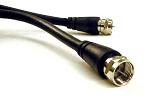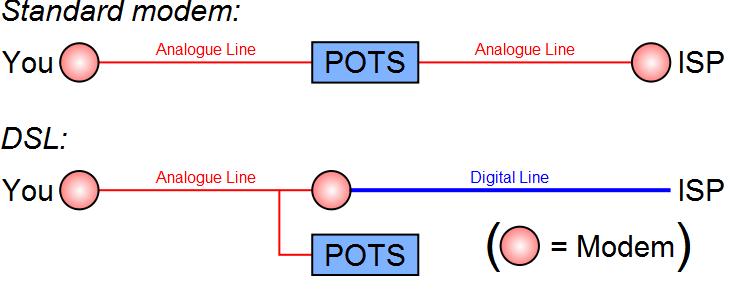|
Cable vs. DSL


P.O.T.S.
Plain Old Telephone Service is a series of filters that are installed on telephone lines and are used to amplify, the vocal frequencies of signals sent over long distances. Since POTS filter out higher frequencies, companies who want to provide DSL service need to install more modems that are suited for higher frequencies. Although this option might be costly, however, it is still cheaper than wiring a new cable connections to residences that never had Cable service.

ADSL
Although most users think they have DSL, it is not actually DSL but ADSL (Asynchronous Digital Subscriber Line). This means that in order to advertise more download speed, the providers decided to dedicate more frequencies to downstream for faster downloads than upstream. This is true for almost all of the home services. The reason why Internet Service Providers (ISP's) do that is because the users do not really need that much upload as compared to download. For example, if you are going to download a movie, all you need in terms of upload is a few kilobits in order to request the file and then it is all up to the download capacity.
How Cable works
Cable works in much the same way as DSL does, however, it uses the coaxial cables (television) cables to transmit data. Aside from this difference in cables there there is also a difference in terms of how the modem that encodes the digital signal is set up. In general DSL companies issue their own modems where as cable companies give you the option of choosing theirs, or buying your own. The charges on the users generally depend on the down speed that the user is subscribed to. The faster the down speed, the more you pay. Since cable modems are all the same, this begs the question on how do they limit the download speeds of the users. Protocol Data Over Cable Service Interface Specifications (DOCSIS) is downloaded into the modem at set up and works to limit the speed at which the user is capable of downloading from the internet to a set speed specified by the ISP. In the case where you decide to upgrade your internet service, all the cable company has to do is to issue another set of Specifications whereas DSL providers might have to issue you a new faster modem. These protocols are hackable and users (at consumer level) have been able to achieve speeds up to 30 Mb per sec.
Additional factors and Pro's and Con's of Each
It is widely thought that cable is a shared internet connection while DSL is not. In essence this is true and the theory is that while the speed of DSL is often slower than Cable your internet connection is often more stable than Cable due to it being a dedicated connection to your home and not shared. In reality Cable connections today are very stable and often much faster than their DSL brothers. DSL also requires that your modem remember a username and password to log you into your ISP each time it connects to the internet. With cable all you have to do is turn the modem on and your ready to go. The issue of username and password only becomes an issue in the event of setup, power loss, and installing a router or wireless gateway. Then it complicates setup and may be too difficult for most common users to configure sucessfully. Both technologies use dynamic IP addressing in the consumer space, and both are priced competitively. Our preference would be cable for its overall faster speed, relative ease of setup and use, and lack of future issues when and if you expand your home or office network.
Conclusion
Cable seems to provide faster speeds than DSL on almost all plans, however, DSL is able to provide access to wider range of people because it is based on telephone lines and the users would not be required to have a cable installation. Also note that ISPs advertise on maximum speeds meaning that these are not speeds you will be able to get ALL the time. ISPs figure that all users on a node will not be using their internet to their maximum capacity all the time therefore they overload the nodes with more users than what the nodes can handle. Most of the users fall into this assumptions, however, with the increase in p2p users which require high bandwidths for prolonged periods of time cable companies may experience issues in the future. As it stands now, cable seems to be the better option for those users that are interested if faster download rates, as for the users that want more kick out of their hard earned buck might seattle with slower speeds at lower rates. Both DSL and Cable provide excellent service, so it is not more of what the is the fastest, but how much you can get for your money.




